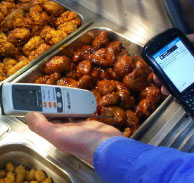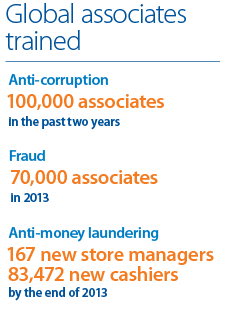Compliance & Sourcing
A global approach

Walmart has maintained a compliance program in each of our markets for years. Throughout 2013, we brought together our 11 separate compliance organizations into a single, coordinated Global Compliance Program. Each of our 2.2 million associates worldwide has a role to play in operating a compliant business. A global approach to compliance is key to our efforts. Coordinating globally helps us to identify best practices in our international markets, as well as common challenges and goals that can be leveraged globally.
Our compliance organization is led by our global, U.S., international and e-commerce chief compliance officers, dedicated senior-level chief compliance officers and anti-corruption officers based in each market. These individuals work closely with our market corporate executive officers, but report directly to a central team at our Walmart Home Office in Bentonville, Ark. As a result of both hiring new associates and clarifying the role of existing associates, there are now more than 2,000 people working worldwide on our global compliance team.
Global compliance organizational structure

Area overviews
Our goal is a consistent, risk-based, Global Compliance Program that leverages technology and subject matter expertise to drive transparency and accountability. The program focuses on 14 key areas:
| Key areas | Description |
| Anti-corruption | We’re dedicated to preventing the use of improper payments, or anything of value, including gifts, hospitality or travel, to secure any improper business advantage from an official or commercial party. |
| Anti-money laundering and financial services | We strive to offer our customers and members financial products and services in a safe, transparent and affordable manner, while protecting them from fraud and other financial crimes. |
| Anti-trust | We promote fair competition with other companies and organizations to prevent unfair business practices, such as agreements with competitors that fix prices or restrict trade. |
| Consumer protection | We work to provide accurate, substantiated and not misleading information to help our customers and members in their buying decisions. |
| Environment | We aim to preserve our natural resources and achieve full compliance with all applicable laws and regulations. Part of that commitment is working to ensure that all our facilities operate in compliance with applicable federal, state and local environmental laws, including the management of environment-related services. |
| Food safety | We support a global food safety culture to provide safe and affordable foods so people can live better. |
| Health and safety | We help protect the well-being of our customers and associates, and provide safe facilities in which to shop and work. |
| Health and wellness | We develop and monitor standard procedures to help ensure compliance with laws, regulations and best practices that govern patient safety, quality of care and privacy, product quality, patient access, billing, development of health and wellness associates and oversight of affiliated health care providers. |
| Labor and employment | We help ensure our associates are paid for the time they work and take legally required meals and breaks, and that we maintain compliance with all applicable labor and employment laws on discrimination, job classification and work authorization. |
| License and permits | We verify that we have all required licenses and permits in every market in which Walmart operates and that they are obtained in a timely and proper manner. |
| Privacy | We work to protect privacy by appropriately collecting, using, securing, retaining and disclosing the personal data of our customers, members, associates and business partners. |
| Product safety | We strive to offer our customers and members safe and affordable merchandise that meets the applicable legal standards. |
| Responsible sourcing | We drive responsibility in our supply chain and lead and inspire others to do the same. |
| Trade | We strive to ensure that we have policies and procedures in place to comply with import and export laws and regulations in each market. |
Global Compliance Program
In order to enable consistency in the way we approach the 14 areas of focus, we’ve developed six building blocks to use across the compliance program.
- Leadership
- Risk assessement
- Monitoring and response
- Standards and controls
- Training
- Communication
2013 program highlights

Anti-corruption
Over the past two years, we’ve focused on further enhancing our Anti-Corruption compliance program via:
- Communicating our ongoing commitment to anti-corruption compliance
- An improved organization structure that utilizes the best talent
- Risk assessments, robust standards and controls designed to prevent, detect and remediate violations
- Consistent training, monitoring and reporting
We provide training in a number of ways, including face-to-face discussions and computer-based learning modules on anti-corruption. Over the past two years, we’ve provided anti-corruption training to more than 100,000 key attendees globally, including those who are likely to have interactions with government officials or who are in a position of authority to influence the company’s actions with regard to anti-corruption issues. This includes store managers, Home Office-level managers, finance associates and individuals who work in real estate and licensing groups, among others.
Leveraging technology to automate processes

Successful compliance programs use technology and systems to ensure consistency and effectiveness. In 2013, we used several important technologies to support and simplify compliance processes for our U.S. and international associates. By using or improving our technology, we can improve program consistency and effectiveness, while benefiting from faster implementation and reduced costs.
In one example this year, we expanded the use of a U.S.-based audit tool to each of our international markets. We also began centralizing our data collection systems to create a global view of our compliance practices and provide a mechanism to enhance our ability to monitor overall compliance risks. By using global mapping technology to consolidate information from otherwise disparate systems and disconnected sources, we are able to monitor large amounts of information, identify trends and take proactive steps to mitigate risk.
Following successful implementation in the U.S. of an automated food safety process and technology called SPARK (Sustainable Paperless Auditing and Record Keeping), we started a project to roll out this technology to each of our international markets over the next few years. This system utilizes hand-held technology, Bluetooth communication and state-of-the-art temperature-measuring devices to monitor and track food safety compliance at every store from a central system.
Finally, technology is helping us train our global associates in a robust, consistent and accessible way. By using automated, computer-based learning modules, thousands of associates all over the world can be trained simultaneously and efficiently on compliance responsibilities specific to their jobs. And since the process is delivered via a centrally controlled system, we can ensure consistency of content and track completion rates. This technology was successfully leveraged in the U.S. and a number of international markets during 2013 and will be expanded to include all markets in the near future.
Fraud and money laundering protection
We’re committed to offering our customers financial products and services in a safe, transparent and affordable manner, while helping to protect from fraud and other financial crimes. In 2013, we enhanced customer receipts for international remittances to include fees, exchange rates, currencies and regulatory disclosures in an effort to ensure our customers have the information they need to make decisions that are right for them and to ensure compliance with regulatory requirements. Approximately 70,000 associates received training as part of this initiative.
We’ve also invested in our leading anti-money laundering monitoring system, in order to improve identification and investigation of suspicious financial activity and reporting to regulators. Finally, we know our associates are an important line of defense in protecting our customers and our business. So, in 2013, we invested in additional fraud and money laundering prevention training for new store managers and cashiers. To date, we’ve trained 167 new store managers and 83,472 new cashiers.

